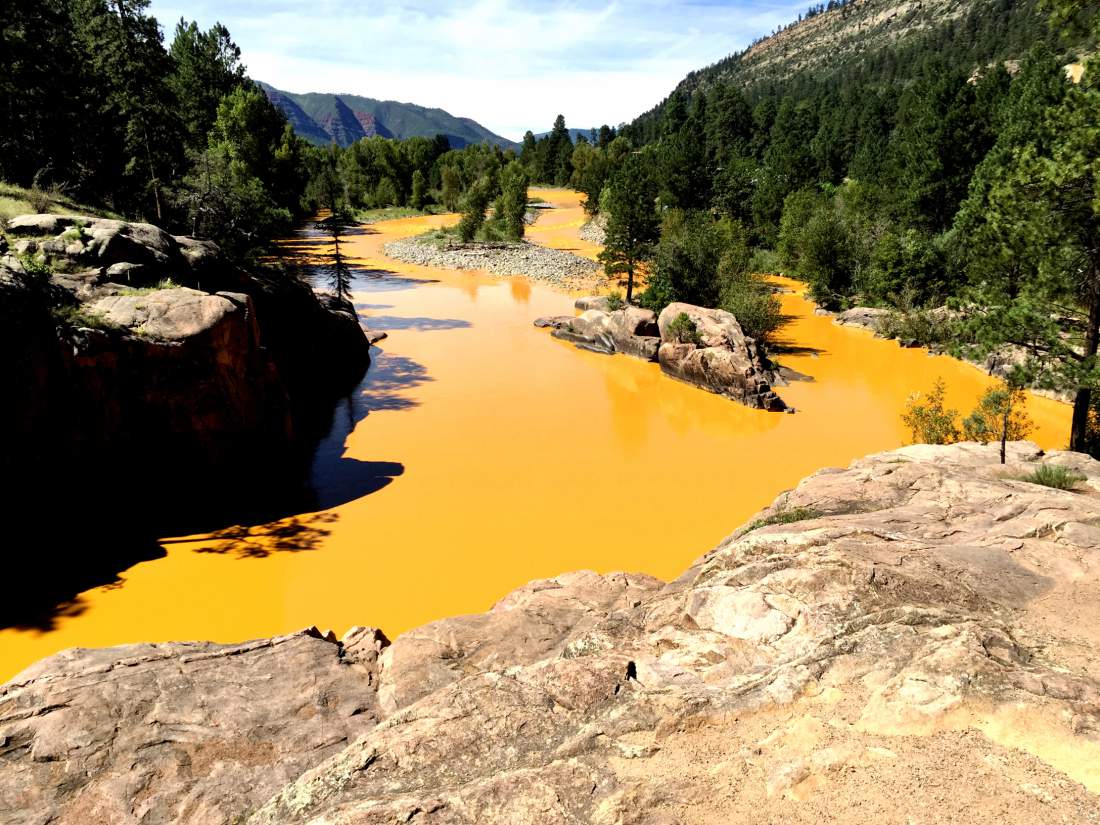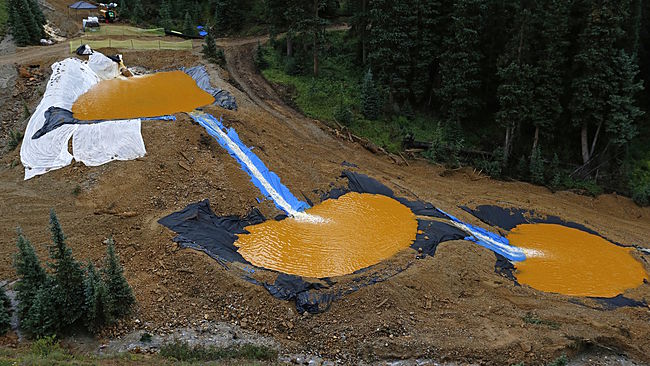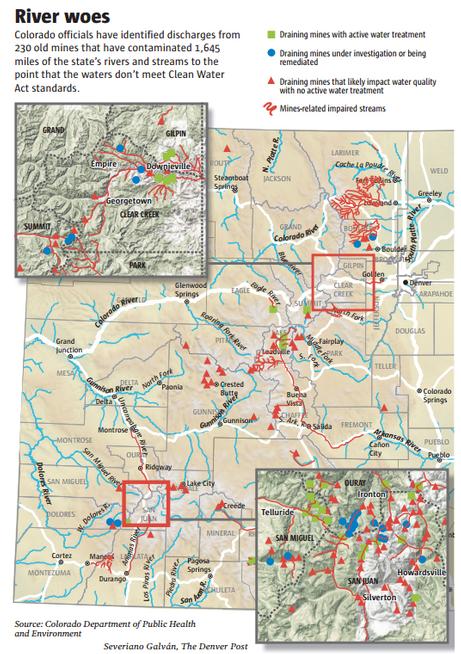Gold King Mine Spill




An average person in America will consume approximately 1.35 million kilograms of minerals, metals and fuel over his/her lifetime, including 425 kg of copper, 12,600 kg of iron ore, 390 kg of lead, and 44 kg of gold.[1] We mine and have mined for these resources, in surface mines and underground mines. Mining is necessary for maintaining our standard of living, but it carries with it the potential of negative impact.
The Gold King claim near Silverton, Colorado, was originally staked by Olaf Nelson in 1887 and development of the Gold King Mine started in 1893. [2] When the mine opened there were over thirty mines operating in San Juan County. Like all mines, Gold King Mine’s life was varied and subject to change but ultimately it was bound to be temporary. Its closure in the 1920s was the result of the difficult economic climate. [3] Today, mine closure typically takes two to ten years, but can take longer if long term water monitoring or treatment is required[4], and mine closure plans are frequently required before a mining permit is initially granted. This was not the case when the Gold King Mine opened. In the 1890s the only regulations for mining were to provide adequate ventilation and to not employ children under 12 years of age. [5]
The Gold King Mine was a very productive mine, producing over 700,000 tons of ore and yielding over $8 million in gross value of gold, silver, lead, and copper. [6] The ore occurs in the Gold King and Davis stringer lodes. [6] (A stringer lode is made up of irregular vein branches that form anastomosing stringers. The irregular nature of a stringer lode requires the whole ore mass to be mined, as the ore is not separable from the country rock.) The Gold King lode is mainly banded quartz and pyrite, but finer grained galena, sphalerite, chalcopyrite, and silver minerals also occur. The white quartz contains the richest concentration of gold in the Gold King lode, whereas gold is associated with pyrite in the Davis lode. [6]
The San Juan Mountains contain hundreds of old mines. Some of these mines were connected. For example the American tunnel, which is the lowest level of the Gold King Mine, extends over a mile to connect with ore bodies 600 ft deep in the Sunnyside Mine. Sunnyside Mine was the most productive, operating from 1875 to 1991. [7]
The sulfide minerals (galena, sphalerite, chalcopyrite, pyrite) that occur in the Gold King Mine naturally oxidize when exposed to air and water (think of a nail rusting). When pyrite is oxidized, sulfuric acid and ferric sulfate are produced. The addition of sulfuric acid to drainage water makes it more acidic, lowering its pH. The increased acidity allows other more toxic metals to be dissolved in the water (e.g. lead, arsenic, cadmium). This process of oxidizing sulfides and acidifying drainage water is known as acid rock drainage. The rate of acid rock drainage is affected by the types of sulfides present, their exposed surface area, the amount of water and oxygen present, temperature, and the presence of microorganisms. [8] Mining increases the potential for acid rock drainage as it exposes additional rock to air and water. Measures to prevent acid rock drainage include storing waste rocks underwater or covering them with clay or soil, flooding and sealing underground mines, treating sulfide waste with bases (e.g. calcite) or organic chemicals that kill microorganisms. [9]
Mines usually close when the ore supply is exhausted or the mine becomes uneconomical to operate. Closing a mine usually requires (1) Decommissioning: mining equipment to be removed, pipelines to be drained, buildings to be demolished or re-used, waste to be disposed; (2) Remediation/Restoration: clean up of contamination, stabilizing of landforms, replanting native plants, etc.; (3) Monitoring and Treatment: remediation/restoration initiatives are assessed, further treatment may be required e.g. for mine water discharge. [4, 10]
In 1996, five years after its closure, the Sunnyside mine was permitted to shut down its water treatment and plug the mine works with concrete. The EPA reported that two nearby sites, the Red and Bonita Mine, and the Mogul Mine, experienced significant increases in discharge, coincident with the Sunnyside work. Before the Sunnyside closure, Red and Bonita discharged approximately five gallons per minute but started discharging 300 gallons per minute after the plug. In 2002, the Animas River Stakeholders Group reported that the nearby Gold King Mine started discharging high amounts of acid rock drainage. [11]
On August 5, 2015, the Environmental Protection Agency was conducting an investigation of the Gold King Mine near Silverton, Colorado, to assess the on-going water releases from the mine, to treat mine water, and to assess the feasibility of further mine remediation. While excavating, pressurized water began leaking above the mine tunnel, spilling about three million gallons of water stored behind the collapsed material into Cement Creek, a tributary of the Animas River. [12] The water contained heavy metals including zinc, iron, arsenic and copper.
When Olaf Nelson originally staked Gold King in 1887, little did he know the future of his claim. So on this Throwback Thursday let’s remember that there are 23,000 abandoned mines in Colorado. 230 of those mines are known to be actively leaking toxic drainage into waterways.
Correction: 25 August 2015
An earlier version of this article incorrectly stated that an average American consumes 2.96 million tons of minerals, metals and fuel over his/her lifetime. The unit is in fact pounds (lbs) not tons, and converts to approximately 1.35 million kgs.
Citations
[1]
www.mineralseducationcoalition.org/pdfs/Baby_Info.pdf [cited 2015 August 20]
[2]
www.historycolorado.org/sites/default/files/files/OAHP/crforms_edumat/pdfs/655.pdf [cited 2015 August 20]
[3] Colorado Mine Inspectors’ Reports: Gold King; Mineral Resources, 1918: 862; "Mining News" EMJ (8/17/18): 325.
[4]
Canada, Natural Resources Canada. 4. Mine Closure, Mining Sequence: Mining Information for Aboriginal Communities, 2011 [cited 2015 August 20]; Available from: www.nrcan.gc.ca/minerals-metals/aboriginal/mining-information-kit/4179.
[5]
www.msha.gov/MSHAINFO/MSHAINF2.HTM
[6]
Burbank, W.S., Luedke, R.G. (1969) Geology and Ore Deposits of the Eureka and Adjoining Districts San Juan Mountains, Colorado. Geological Survey Professional Paper 535. pubs.usgs.gov/pp/0535/report.pdf
[7] Rosemeyer, T. (1988) History and Mineralogy of the Sunnyside mine, Eureka mining district, San Juan County, Colorado, New Mexico Mineral Symposium November 12-13, 1988
[8] Lottermoser, B., (2012) Mine Wastes: Characterization, Treatment and Environmental Impacts, Springer: New York. p. 400.
[9] Johnson, D.B. and K.B. Hallberg (2005) Acid Mine Drainage Remediation Options: A Review. Science of The Total Environment. 338: p. 3-14.
[10] Champigny, N. (1991) International Survey of Mine Reclamation and Funding, Proceedings of the 15th Annual British Columbia Mine Reclamation Symposium; The Technical and Research Committee on Reclamation.
[11] http://www.animasriverstakeholdersgroup.org/attachments/File/DRAFTTimelineforUpperAnimas9-15-14.pdf [cited 2015 August 20]
[12]
www2.epa.gov/goldkingmine [cited 2015 August 20]
